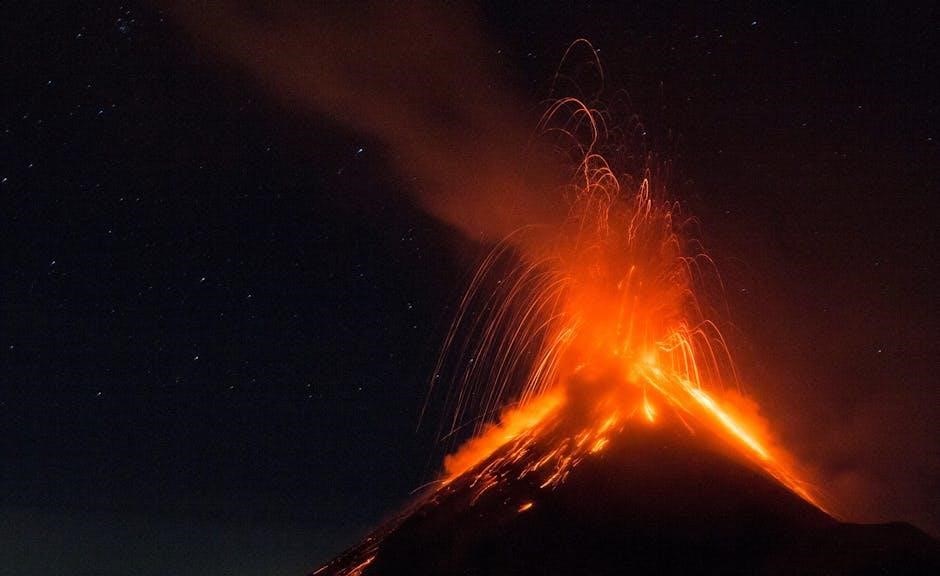Plate tectonics worksheet pdf explains earth’s surface and rock structures formation, using
- ordered lists
and
- unordered lists
to describe the process, providing a comprehensive introduction to the subject matter clearly․
Definition of Plate Tectonics
The term plate tectonics refers to the forces that shape Earth’s surface and the rock structures that form as a result․ This concept is crucial in understanding the Earth’s surface and the processes that shape it․ According to the internet, plate tectonics is defined as the movement of the Earth’s lithosphere, which is the outermost solid layer of the planet․ The lithosphere is broken into several large plates that move relative to each other, creating and shaping the Earth’s surface; The movement of these plates is responsible for the formation of mountains, volcanoes, and earthquakes․ The definition of plate tectonics is essential in understanding the Earth’s geological history and the processes that continue to shape our planet today․ Using
- ordered lists
and
- unordered lists
can help to explain the different aspects of plate tectonics and how they interact with each other to shape the Earth’s surface․ By understanding the definition of plate tectonics, we can better appreciate the dynamic nature of our planet․
Importance of Plate Tectonics Theory
The importance of plate tectonics theory lies in its ability to explain the Earth’s geological features and processes․ The theory provides a framework for understanding the movement of the Earth’s lithosphere and the resulting formation of mountains, volcanoes, and earthquakes․ According to the internet, plate tectonics theory is essential for understanding the Earth’s history and the processes that shape our planet․ The theory has been widely accepted by the scientific community and has revolutionized the field of geology․ Using
and
can help to illustrate the importance of plate tectonics theory and its applications․ By understanding the importance of plate tectonics theory, we can better appreciate the dynamic nature of the Earth and the processes that shape our planet․ The theory has also led to a greater understanding of natural hazards such as earthquakes and volcanic eruptions, and has improved our ability to predict and prepare for these events․ This knowledge is essential for mitigating the effects of these hazards and protecting human life and property․

Plate Tectonics Lesson Plan Worksheets
Plate tectonics lesson plans use
- ordered lists
and links to engage students in learning about earth’s surface processes clearly and effectively every day․
Components of the Lesson Plan
The components of the lesson plan include a variety of materials such as worksheets, diagrams, and maps to help students understand the concept of plate tectonics․ These materials are designed to be used in conjunction with each other to provide a comprehensive learning experience․ The lesson plan also includes a teacher’s guide, which provides instructions and tips for presenting the material to students․ The guide includes information on how to use the worksheets and diagrams, as well as suggestions for activities and discussions to enhance student learning․ Additionally, the lesson plan includes a section on assessment, which provides guidance on how to evaluate student understanding of the material․ The assessment section includes sample questions and answers, as well as suggestions for projects and presentations that students can complete to demonstrate their knowledge․ By using these components, teachers can create a well-rounded and engaging lesson plan that helps students learn about plate tectonics․ The lesson plan is flexible and can be adapted to meet the needs of different students and classrooms․
Administration of the Lesson Plan
The administration of the lesson plan involves several steps, including preparing the materials, introducing the concept of plate tectonics, and guiding students through the activities․ The teacher should begin by printing out the worksheets and diagrams, and making sure that each student has a copy․ The lesson plan can be administered in a variety of ways, including in a classroom setting or as a homework assignment․ The teacher should also be prepared to answer questions and provide additional support to students who need it․ The lesson plan is designed to be flexible, and can be adapted to meet the needs of different students and classrooms․ The teacher can use a variety of methods to administer the lesson plan, including lectures, discussions, and hands-on activities․ By following the steps outlined in the lesson plan, teachers can help students learn about plate tectonics in a fun and engaging way․ The administration of the lesson plan is an important part of the learning process․

Tectonic Plates Map Worksheet
Using maps and images to identify plate boundaries and tectonic plates clearly․
Directions for the Map Worksheet
To complete the map worksheet! students will need to use a combination of geographic and geologic information to identify the different tectonic plates and their boundaries․ The worksheet will include a series of questions and activities that require students to analyze the map and make connections between the different features․ Students will need to use their knowledge of plate tectonics to identify the types of plate boundaries and the processes that occur at each boundary․ The worksheet will also include space for students to record their answers and explain their reasoning․ By completing the map worksheet, students will demonstrate their understanding of the concepts of plate tectonics and their ability to apply this knowledge to real-world scenarios․ The map worksheet is an essential tool for assessing student learning and understanding of the subject matter, using
- ordered lists
and
- unordered lists
to guide the students․
Types of Plate Boundaries
The plate tectonics worksheet pdf explains the three main types of plate boundaries, including divergent, convergent, and transform boundaries, using
and
to illustrate the concepts․ Divergent boundaries occur where two plates are moving apart, resulting in the creation of new crust and the formation of volcanoes and mid-ocean ridges․ Convergent boundaries occur where two plates are moving towards each other, resulting in subduction, collision, or mountain building․ Transform boundaries occur where two plates are sliding past each other, resulting in faulting and earthquake activity․ The worksheet provides detailed descriptions and examples of each type of boundary, allowing students to understand the unique characteristics and processes that occur at each․ By studying the types of plate boundaries, students can gain a deeper understanding of the dynamic nature of the Earth’s surface and the processes that shape it, using geographic information systems and remote sensing to analyze the data․ The worksheet is designed to help students learn and apply this knowledge in a practical way․

History of Plate Tectonics Theory

Plate tectonics theory emerged in the 1960s, using links and images to describe the development of the theory clearly and concisely online always․
Development of the Theory
The development of the plate tectonics theory involved the work of many scientists, using links and images to describe the process․ The theory was formed by combining several existing ideas, including continental drift and seafloor spreading․ The development of the theory was a gradual process, with many scientists contributing to its formation over time․ The use of
- ordered lists
and
- unordered lists
helped to clarify the concept of plate tectonics, making it easier to understand and study․ The theory of plate tectonics has had a significant impact on our understanding of the Earth’s surface and the processes that shape it․ The development of the theory has also led to a greater understanding of natural disasters, such as earthquakes and volcanoes․ By studying the movement of the Earth’s plates, scientists can better understand these events and how they occur․ This knowledge can be used to help predict and prepare for natural disasters․
Key Concepts of the Theory
The key concepts of the plate tectonics theory include the idea that the Earth’s surface is divided into large plates that move relative to each other․ These plates are in constant motion, sliding over the more fluid mantle below, and interacting at their boundaries․ The use of
and
can help to illustrate these concepts, making them easier to understand․ The theory also explains how the movement of these plates can cause earthquakes, volcanoes, and the creation of mountain ranges․ By studying the plate tectonics theory, students can gain a deeper understanding of the Earth’s surface and the processes that shape it․ The theory is supported by a wide range of evidence, including seismic data, gravity measurements, and the fit of the continents․ The key concepts of the theory are essential for understanding the Earth’s geology and the processes that have shaped our planet over millions of years, using span and
elements to organize the content․
